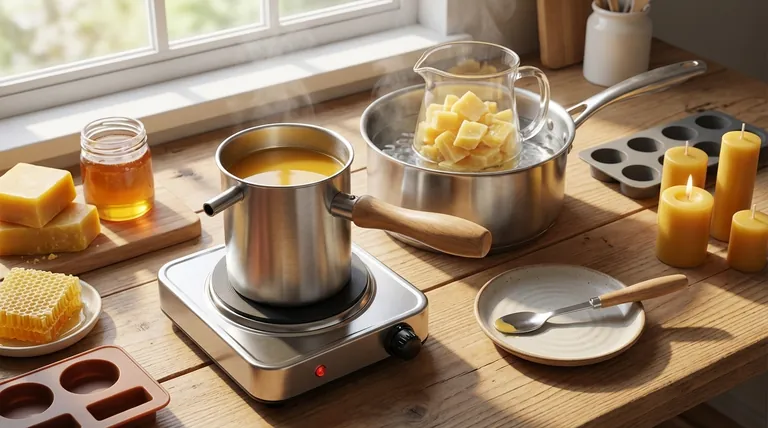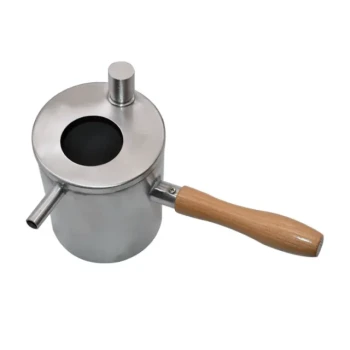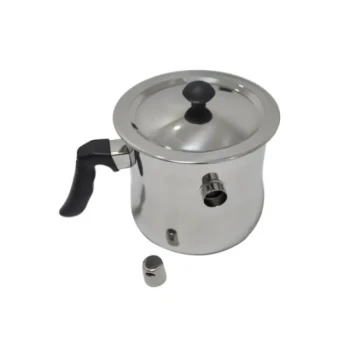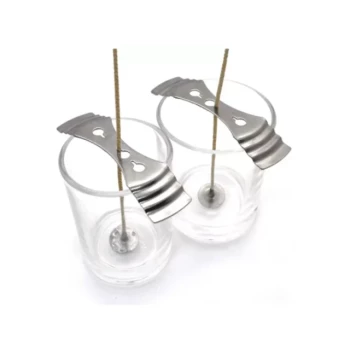The key to melting beeswax without a mess is using controlled, indirect heat. The most reliable and accessible way to achieve this is with a double boiler, which gently liquefies the wax without scorching it or creating a fire hazard. This method gives you complete control over the process, from melting to pouring.
The core challenge of melting beeswax isn't just the wax itself, but the lack of a controlled system. A mess-free outcome is achieved by using indirect heat to prevent splatters and dedicating specific, easy-to-clean tools to the task.

Why Direct Heat Is a Problem
Placing beeswax directly in a pot on a stove is a common mistake that leads to mess and danger. Understanding why this approach fails is crucial for success.
The Risk of Scorching and Discoloration
Beeswax has a low melting point, around 147°F (64°C). Direct heat from a stove burner is intense and uneven, quickly exceeding this temperature.
This causes the wax to scorch, turning it dark brown, ruining its color, and imparting a burnt smell.
The Danger of Flammability
If overheated, beeswax can release flammable vapors. A pot of wax on direct heat can easily reach its flash point and ignite, creating a dangerous grease fire that cannot be extinguished with water.
The Safest Method: The Double Boiler
The double boiler is the industry-standard method for a reason: it's safe, slow, and provides even, gentle heat. It makes the entire process predictable and clean.
The Standard Double Boiler
A true double boiler consists of two pots that nest together. Water is heated in the bottom pot, and the steam gently heats the top pot containing the beeswax. This indirect heat prevents the wax from ever getting significantly hotter than the boiling point of water (212°F or 100°C).
The DIY Double Boiler
You can easily create your own double boiler. Simply place a heat-safe container, like a glass measuring cup or a dedicated metal pitcher, inside a larger saucepan filled with a few inches of water.
This setup achieves the same result as a standard double boiler and is perfect for most hobbyist needs.
Best Practices for This Method
Gently stir the wax as it melts to ensure it heats evenly. Never leave melting wax unattended, even when using this safe method. Once melted, the wax is ready for filtering or pouring.
Alternative Method: The Crock-Pot (Slow Cooker)
For larger batches or for performing an initial cleaning pass on raw wax, a crock-pot or slow cooker is an excellent option.
The Water-Bath Technique
A popular technique for cleaning raw beeswax is to place the wax chunks directly into the crock-pot and cover them with water.
Set the cooker to low. As the wax melts, heavy debris will sink into the water layer. Once you turn off the heat and let it cool, the wax will form a solid, clean disk on top of the dirty water, which can be easily lifted out.
When to Use a Crock-Pot
This method is ideal for beekeepers processing cappings or anyone starting with impure, raw wax. It combines the melting and initial cleaning steps into one efficient process.
Understanding the Trade-offs and Pitfalls
A clean process requires anticipating the challenges. The primary issues with beeswax are managing its temperature and containing its stickiness.
The Challenge of Cleanup
Beeswax hardens quickly and is difficult to remove from pots, utensils, and drains. The most effective strategy is not to clean it up, but to contain it from the start.
Dedicate your tools. Use a specific pot, pitcher, and stirring utensil only for wax work. This eliminates the need for frustrating cleanup of your everyday kitchen equipment.
The Inefficiency of Solar Melters
Solar melters use the sun's heat to gently melt wax in an insulated box. While effective and energy-free, they are slow and dependent on weather.
This method is best suited for beekeepers with large quantities of wax and outdoor space, not for quick, indoor projects.
The Risk of Microwaves
Never melt beeswax in a microwave. The heating is extremely uneven, creating superheated hot spots that can flash ignite inside the microwave, posing a serious fire risk.
Making the Right Choice for Your Project
Your goal determines the best method. By matching the technique to the task, you ensure a clean and successful outcome.
- If your primary focus is safety and control for small batches: Use a standard or DIY double boiler for the most predictable results.
- If you are processing raw wax and want to combine melting with cleaning: Use the crock-pot water-bath technique to save time and effort.
- If your primary focus is avoiding contamination of kitchenware: Dedicate a specific pitcher or pot exclusively for beeswax and pour into silicone molds for easy release.
By controlling the heat and dedicating your tools, you transform a potentially messy task into a clean and predictable process.
Summary Table:
| Method | Best For | Key Advantage |
|---|---|---|
| Double Boiler | Small batches, safety, control | Gentle, indirect heat prevents scorching |
| Crock-Pot (Slow Cooker) | Large batches, cleaning raw wax | Combines melting and initial cleaning |
| Solar Melter | Large outdoor quantities, low energy | Energy-free, but slow and weather-dependent |
Need reliable equipment for your beekeeping operation?
As a trusted wholesale supplier to commercial apiaries and distributors, HONESTBEE provides the durable, high-quality tools you need for efficient wax processing and all your beekeeping tasks. From dedicated melting pitchers to large-capacity equipment, we help you work cleaner and smarter.
Contact our team today to discuss your supply needs and get a quote tailored for your business.
Visual Guide

Related Products
- Professional Stainless Steel Wax Melter for Beekeeping and Crafts
- Beeswax Melter for Candle Making Honey Bee Wax Melter
- Steam Beeswax Melter Wax Warmer for Wax Processing
- Electric Flatting and Embossing Machine with Tray for Beekeeping
- 3D Square Honeycomb Pillar Silicone Candle Molds for Making Beeswax Candles
People Also Ask
- What temperature range is considered gentle heat for melting beeswax? Preserve Aroma & Color
- What are the steps for using a wax melter to melt beeswax? Master Safe, Efficient Beeswax Processing
- What is the flashpoint of beeswax? Essential Safety and Quality Tips for Beekeepers
- How can you monitor the temperature of beeswax as it melts? Ensure Quality & Safety with Precise Control
- Can I melt beeswax in a wax melter? The Key to Safe, High-Quality Results



















